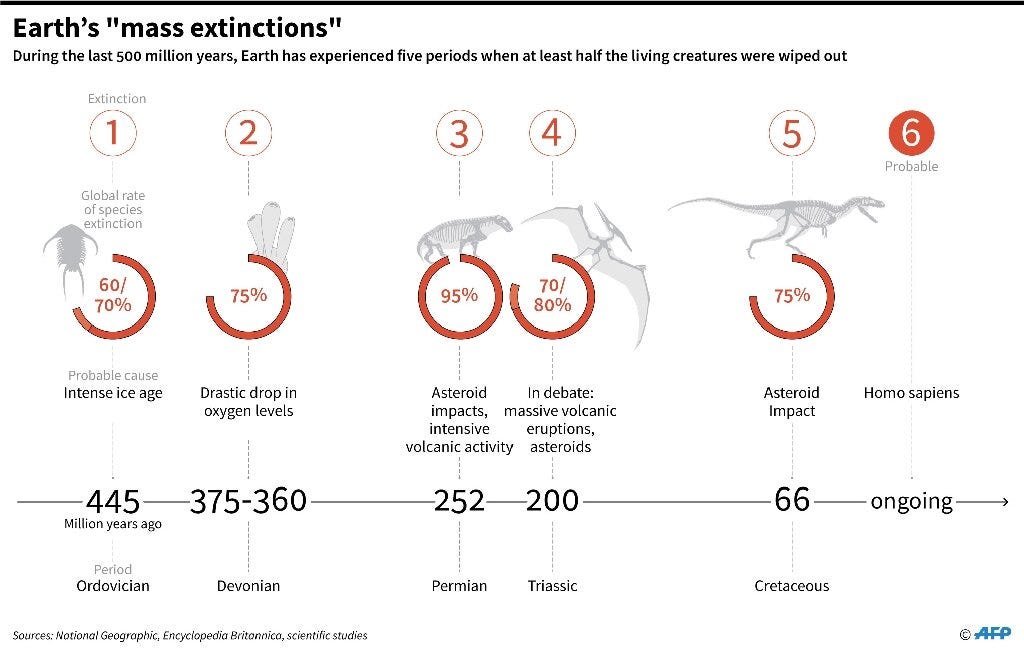The sixth mass extinction?
Mass extinctions refer to moments in Earth's history when abnormally large numbers of species die off simultaneously or within a limited time frame.
In this article, we take a short look at mass extinction events, and evaluate the on-going 6th mass extinction.
Our planet has faced 5 significant mass extinction events in its history.

The Ordovician-Silurian Extinction (445 million years ago) - Caused by glaciation and changes in sea levels, this event wiped out an estimated 85% of all marine species.
The Late Devonian Extinction (360-375 million years ago) - Many factors contributed to this extinction, including meteorite impacts, plant evolution, and changes in the availability of oxygen in the oceans. 75% of all species were lost during this event.
The Permian-Triassic Extinction (252 million years ago) - Also known as "The Great Dying," resulted in the loss of 96% of all marine species and 70% of terrestrial vertebrate species. It is likely due to a combination of massive volcanic activity, methane hydrate gasification, and the release of CO2.
The Triassic-Jurassic Extinction (200 million years ago) - This event led to the loss of 50% of all species. It allowed for the rise of the dinosaurs, as many of their competitors were wiped out. The causes remain debatable, but volcanic activity is a leading theory.
The Cretaceous-Paleogene Extinction (66 million years ago) - Probably the most famous extinction event, it led to the disappearance of the non-avian dinosaurs. A giant asteroid impact, combined with volcanic activity, is widely believed to have caused this extinction, wiping out 75% of all species on Earth.
>- note that all numbers are rough estimates.
The Anthropocene Extinction
The sixth mass extinction is happening as we speak. Scientists talk about the Holocene or Anthropocene Extinction. Unlike previous mass extinctions, this one is attributed to human activity. The impact of human activity - usage of glyphosate, emissions of NOx, destruction of forests - translates into habitat destruction, pollution, climate change, and the introduction of invasive species.
Some facts about the ongoing mass extinction:
Fish: Around 34% of the world's assessed fish stocks were classified as overfished in 2017, with a 71% decline in the biomass of oceanic sharks and rays since 1970, mainly due to overfishing.
Wild Animals: The "Living Planet Report 2020" indicated a 68% decline in populations of mammals, birds, amphibians, reptiles, and fish between 1970 and 2016, with over 31.000 species threatened with extinction according to the IUCN's 2020 Red List.
Insects: A review in 2019 found that 40% of insect species could become extinct in the coming decades, and a study in Germany revealed a 76% decline in flying insect biomass in protected areas over 27 years.
While the Anthropocene Extinction is still ongoing, its impact is already huge with exctinctions of some species in the 40 to 75% range (vs. 70-95% for previous extinctions).
Sources:
FAO's "The State of World Fisheries and Aquaculture 2020"
WWF's "Living Planet Report 2020"
IUCN Red List
"Worldwide decline of the entomofauna: A review of its drivers" in Biological Conservation, 2019
"More than 75 percent decline over 27 years in total flying insect biomass in protected areas" in PLOS ONE, 2017


